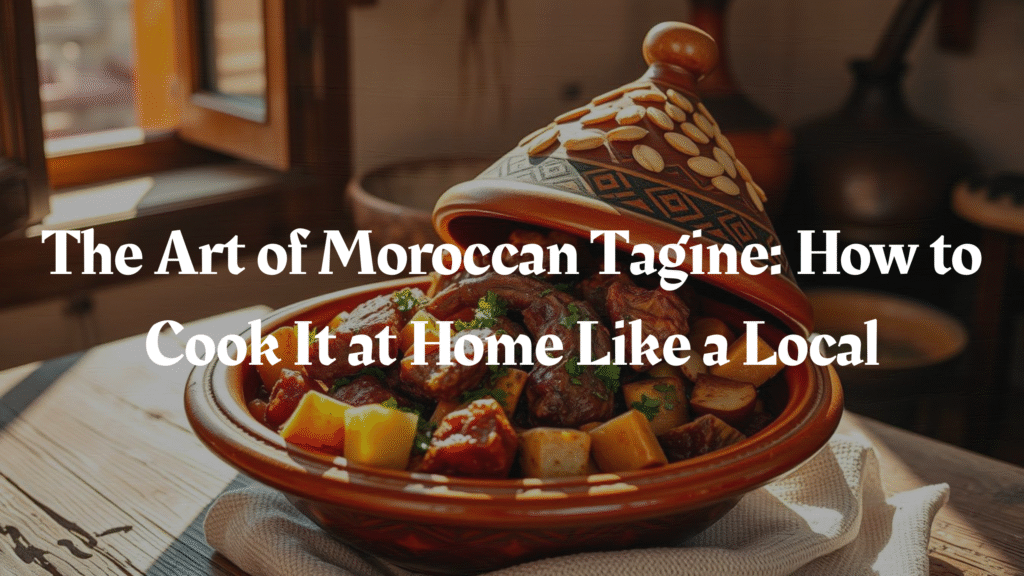How to cook Tagine Like a Pro
Imagine savoring a rich, aromatic stew that’s been a staple of North African cuisine for centuries. You’re about to embark on a culinary journey to master the traditional moroccan tagine, a dish that’s both flavorful and culturally significant.
Cooking authentic tagine at home is easier than you think. With a few simple ingredients and some guidance, you’ll be able to recreate this beloved dish, impressing your family and friends with your culinary skills.
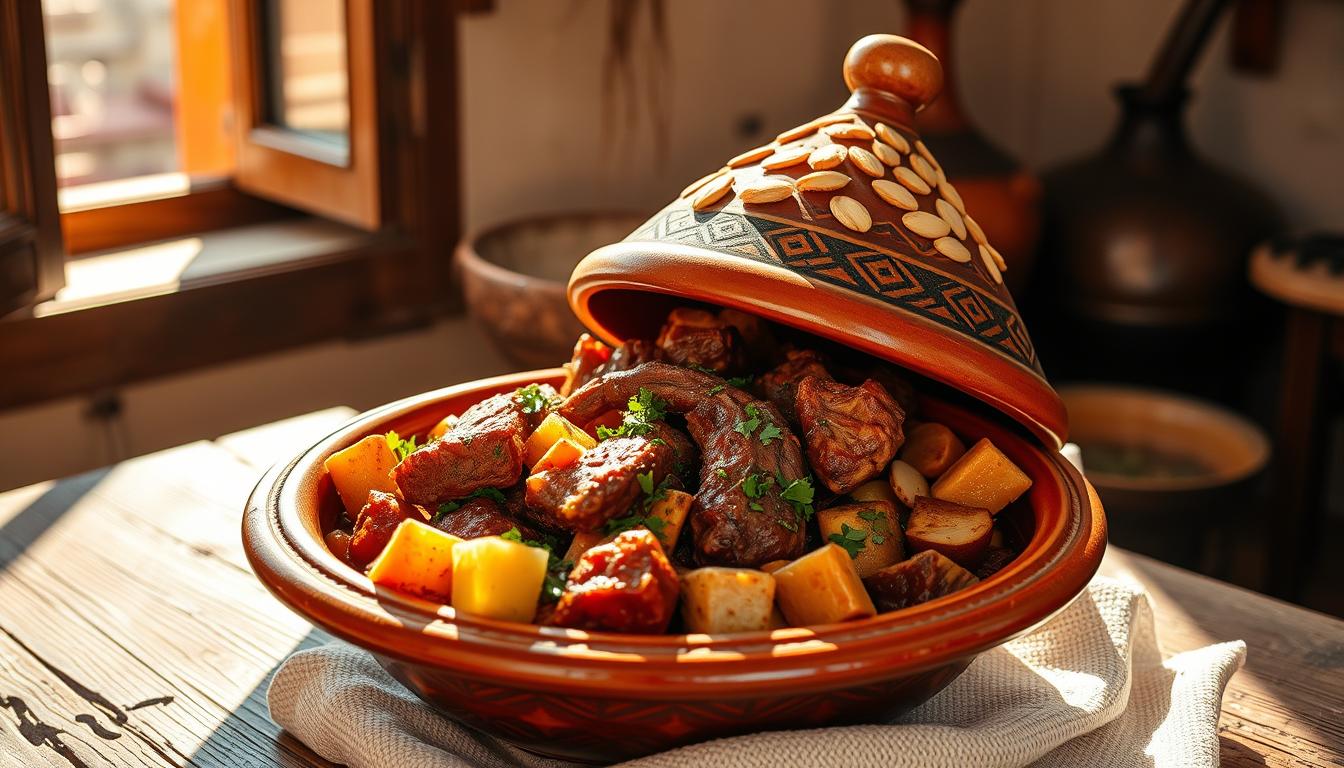
As you explore the world of moroccan tagine recipe, you’ll discover the secrets behind its rich flavors and tender ingredients. By the end of this article, you’ll be confident in your ability to cook an authentic tagine recipe that rivals those found in the souks of Marrakech.
Understanding the Moroccan Tagine Tradition
Tagine, a staple ofMoroccan cuisine, is a flavorful stew that’s both nourishing and aromatic. This traditional dish is named after the earthenware pot in which it’s cooked, characterized by its distinctive conical lid.
What is a Tagine?
A Tagine is a slow-cooked stew made with a variety of ingredients, including meat, vegetables, and dried fruits, all cooked in a traditional clay pot.
The Cultural Significance of Tagine in Morocco
The cultural significance of Tagine in Morocco cannot be overstated. It’s a dish often served on special occasions and is central to family gatherings and celebrations.
- Tagine is a symbol of hospitality and community.
- It’s a dish that brings people together.
- The slow-cooking process allows for a rich exchange of flavors.
Understanding the traditional Moroccan Tagine is key to appreciating Moroccan culture. It’s not just a meal; it’s an experience that embodies the country’s rich culinary heritage.
The History Behind This Iconic Dish
As you explore the rich culinary landscape of Morocco, you’ll discover that the tagine is more than just a dish, it’s a culinary icon steeped in history. The story of tagine cooking is a fascinating tale of cultural exchange, geographical influences, and culinary innovation.
Origins of Tagine Cooking
The origins of tagine cooking date back to the Berber tribes of North Africa. The name « tagine » refers not only to the dish itself but also to the distinctive clay pot in which it’s cooked. This traditional cooking vessel is designed to allow slow cooking over low heat, infusing the food with rich flavors.
How Tagine Evolved Through Centuries
Over the centuries, tagine cooking has evolved, influenced by various cultures, including Arab, Mediterranean, and African cuisines. Key factors in its evolution include:
- The introduction of new spices and ingredients from trade routes
- The adaptation of cooking techniques from different cultures
- The incorporation of local ingredients and preferences
This blend of influences has resulted in the rich, complex flavors characteristic of traditional Moroccan tagine.
Essential Equipment for Authentic Moroccan Tagine
The journey to an authentic Moroccan Tagine begins with understanding the essential cooking vessels and tools. At the heart of any Tagine dish is the Tagine pot itself.
Traditional Clay Tagine Pots vs. Modern Alternatives
Traditional clay Tagine pots are preferred for their ability to distribute heat evenly and retain moisture. However, modern alternatives, such as ceramic or cast-iron Tagines, offer durability and ease of maintenance. When choosing between traditional and modern Tagine pots, consider your cooking style and preferences.
How to Season and Care for Your Tagine Pot
Seasoning your clay Tagine pot is crucial before its first use. This involves applying a layer of oil and heating it to prevent cracking. Regular cleaning with mild soap and water, and avoiding harsh chemicals, will extend the life of your Tagine pot.
Other Helpful Tools and Utensils
In addition to the Tagine pot, other useful tools include a mortar and pestle for spice preparation, a sharp knife for cutting ingredients, and a wooden spoon for stirring. A table outlining the essential tools is provided below for your convenience.
| Tool | Purpose |
|---|---|
| Tagine Pot | Cooking the Tagine |
| Mortar and Pestle | Preparing spices |
| Sharp Knife | Cutting ingredients |
| Wooden Spoon | Stirring the Tagine |
By investing in the right equipment and learning how to care for it, you’ll be well on your way to creating delicious, authentic Moroccan Tagines.
Key Ingredients in Traditional Moroccan Tagine
The foundation of a delicious Tagine is built upon the selection of key ingredients, including meats, vegetables, fruits, and spices. These components work together to create the complex flavors that characterize this traditional Moroccan dish.
Meat Options: Lamb, Chicken, Beef, and Fish
When it comes to choosing the protein for your Tagine, you have several options. Lamb is a popular choice due to its rich flavor and tender texture when slow-cooked. Chicken is another favorite, offering a leaner alternative that still absorbs the flavors well. Beef can be used for a heartier Tagine, while fish is ideal for a coastal-inspired version.
Essential Vegetables and Fruits
Vegetables and fruits play a crucial role in adding depth and variety to your Tagine. Common ingredients include onions, carrots, and potatoes for a hearty base, while prunes or dried apricots can add a sweet contrast to the savory elements.
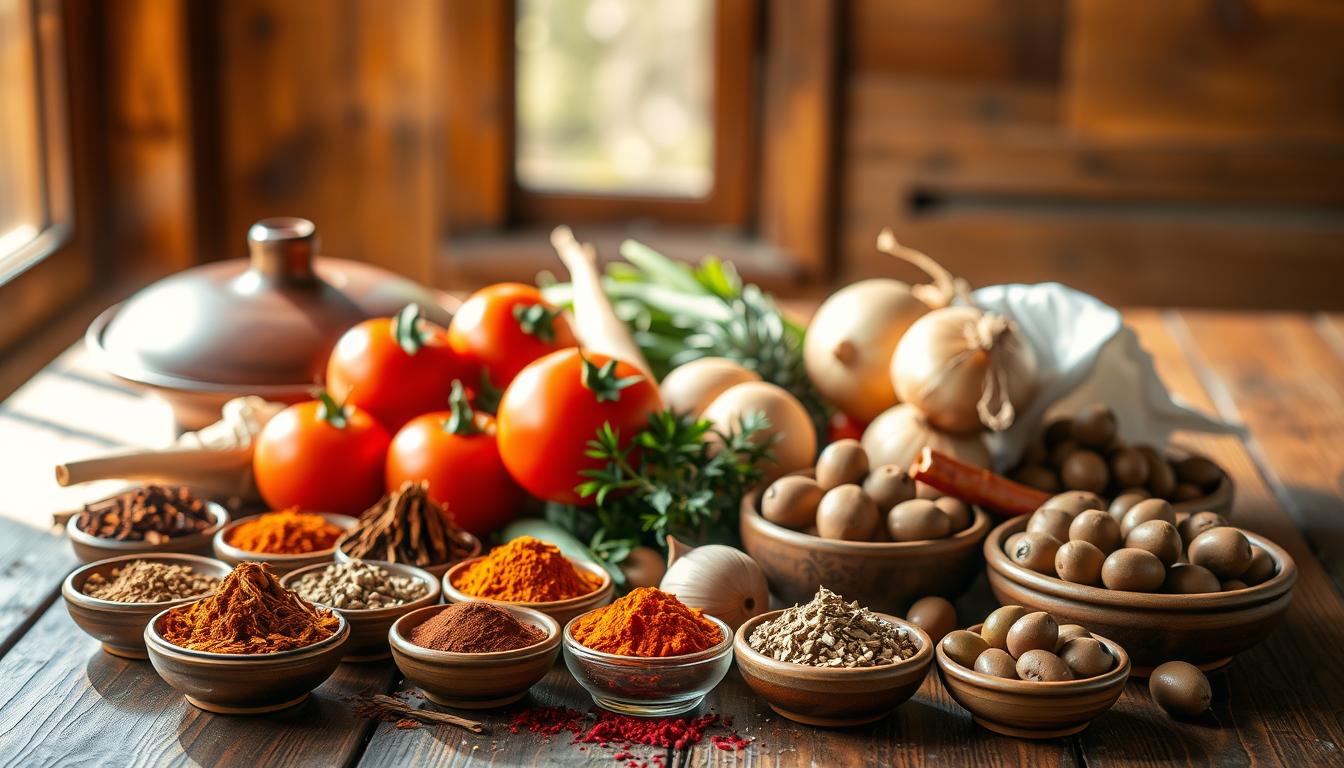
Authentic Moroccan Spices and Herbs
The distinct flavor of Tagine is largely due to the blend of Moroccan spices and herbs used. Key spices include cumin, coriander, ginger, and turmeric, which together create a warm, aromatic flavor profile.
Preserved Lemons and Olives
Preserved lemons and olives are two ingredients that add a unique salty, tangy flavor to the Tagine. Preserved lemons are made by pickling lemons in a brine solution, giving them a distinctive taste that enhances the overall dish.
| Ingredient | Description | Role in Tagine |
|---|---|---|
| Lamb | Rich, tender meat | Main protein source |
| Preserved Lemons | Salty, tangy flavor | Adds depth and complexity |
| Cumin | Warm, earthy spice | Contributes to the aromatic flavor |
| Olives | Salty, savory flavor | Enhances the overall taste |
Preparing Your Ingredients the Moroccan Way
Before you start cooking your tagine, it’s essential to understand the traditional Moroccan way of preparing ingredients. This preparation is what sets the foundation for the rich, complex flavors that tagine is known for.
Proper Meat Preparation Techniques
You should cut your meat into bite-sized pieces, typically around 1-1.5 inches. For lamb or beef, it’s common to include some pieces with bone for added flavor. Marinating the meat in a mixture of olive oil, spices, and herbs for at least 30 minutes is recommended.
Vegetable Cutting Styles
Vegetables are usually cut in a way that they cook evenly. For example, carrots are often sliced into coins, while onions are chopped finely. The key is to ensure that all vegetables are cut to a size that allows them to cook thoroughly within the cooking time.
Creating a Balanced Spice Mixture
A balanced spice mixture is crucial for an authentic tagine flavor. This typically includes a mix of ground spices like cumin, coriander, cinnamon, and turmeric, along with fresh herbs such as parsley and cilantro. The proportions can vary based on personal preference and regional traditions.
| Spice/Herb | Typical Use in Tagine | Flavor Profile |
|---|---|---|
| Cumin | Ground, added early in cooking | Earthy, warm |
| Coriander | Ground, mixed with other spices | Citrusy, slightly sweet |
| Cinnamon | Stick or ground, adds depth | Warm, sweet |
Step-by-Step Authentic Moroccan Tagine Recipe
Embarking on the journey of cooking Moroccan Tagine at home can be a rewarding experience, and we’re here to guide you through it. This traditional North African dish is known for its rich flavors and slow-cooked ingredients, typically prepared in a clay pot with a conical lid.
Preparing the Base Layer
The foundation of a great Tagine starts with its base layer. Begin by heating a couple of tablespoons of olive oil in the bottom of your Tagine pot or a heavy-bottomed Dutch oven. Add sliced onions and cook until they’re softened and lightly browned. This step is crucial as it lays the flavor foundation for your dish.
Adding and Arranging Ingredients
Once your onions are ready, it’s time to add the main ingredients. For a classic lamb Tagine, add chunks of lamb shoulder or neck, along with your choice of vegetables such as carrots, potatoes, or zucchini. Arrange the ingredients in a harmonious layer, ensuring that the meat is mostly covered by the vegetables. This not only promotes even cooking but also adds to the visual appeal of the dish.
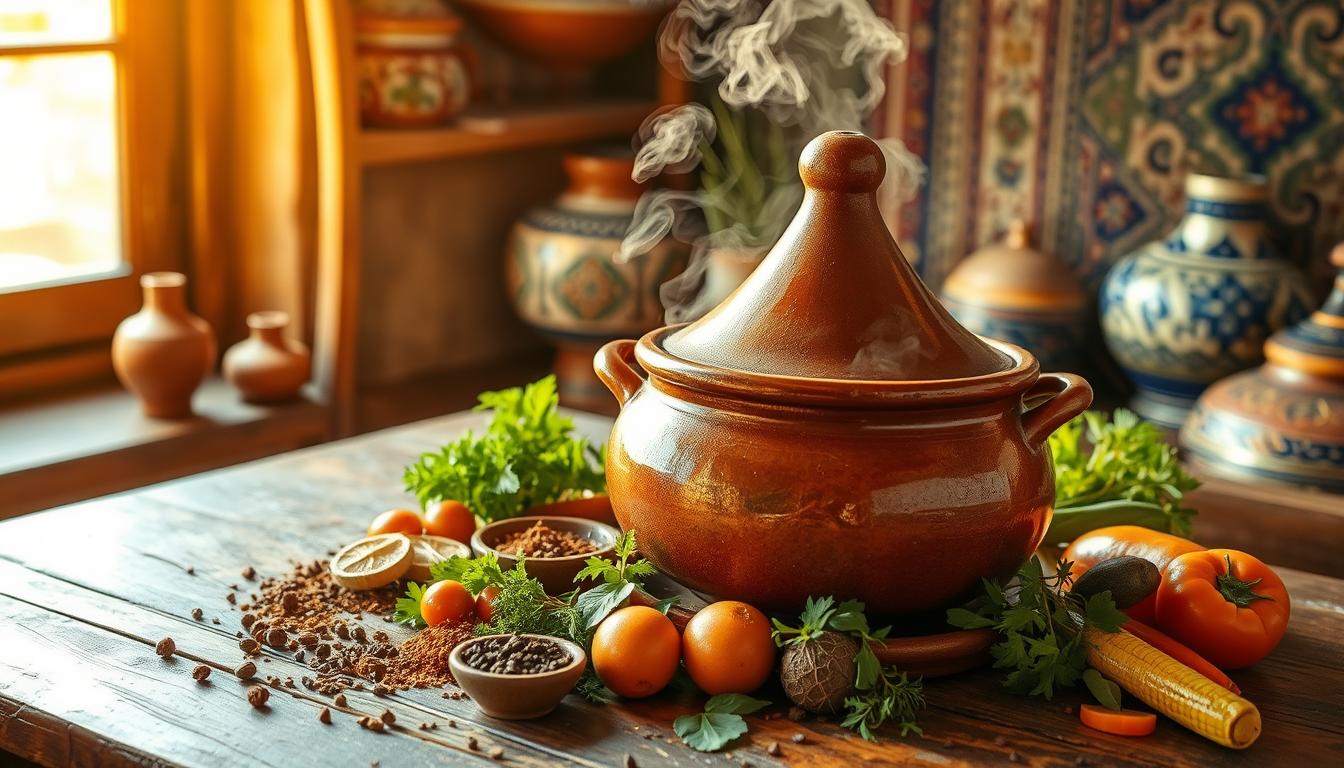
Cooking Times and Temperatures
Cooking a Tagine is a slow process that requires patience. Typically, you’ll simmer your Tagine over low heat for about 1.5 to 2 hours. The exact cooking time can vary depending on the ingredients and their tenderness. It’s essential to keep the heat low to prevent the sauce from boiling vigorously, which can lead to a tough, dry dish.
How to Know When Your Tagine is Done
The Tagine is done when the meat is tender, and the sauce has thickened to your liking. You can check for doneness by inserting a fork or knife into the meat; if it slides in easily, it’s ready. Additionally, the flavors should have melded together, creating a rich, aromatic sauce.
| Ingredient | Cooking Time | Notes |
|---|---|---|
| Lamb | 1.5 – 2 hours | Slow-cooked until tender |
| Chicken | 1 – 1.5 hours | Can be cooked faster than lamb |
| Vegetables | Varies | Cooking time depends on the vegetable |
By following these steps and tips, you’ll be well on your way to creating an authentic Moroccan Tagine that’s sure to impress. Remember, the key to a great Tagine is in the slow cooking and the balance of flavors.
Regional Variations of Moroccan Tagine
As you travel through Morocco, you’ll discover that Tagine takes on different flavors and characteristics in various regions. This diversity is a reflection of the country’s rich cultural heritage and geographical variety.
Northern Moroccan Tagine Styles
In Northern Morocco, Tagine is often influenced by Mediterranean and European cuisines. Northern Moroccan Tagine styles frequently incorporate ingredients like olives, preserved lemons, and artichokes, creating a unique flavor profile.
Southern and Berber Tagine Traditions
The Southern regions and Berber communities have their own distinct Tagine traditions. These variations often feature locally sourced ingredients such as dates, prunes, and specific types of meat or vegetables, reflecting the desert and mountainous landscapes.
| Region | Common Ingredients | Cooking Techniques |
|---|---|---|
| Northern Morocco | Olives, preserved lemons, artichokes | Slow-cooked with Mediterranean spices |
| Southern Morocco | Dates, prunes, local meats | Cooked with Berber spices and herbs |
| Coastal Regions | Seafood, garlic, fresh herbs | Quick-cooked with a focus on freshness |
Coastal Seafood Tagine Variations
Coastal regions in Morocco feature seafood Tagine variations that are rich in fish, shrimp, and other seafood delicacies. These Tagines are often cooked with garlic, fresh herbs, and a touch of cumin, highlighting the freshness of the seafood.
Exploring these regional variations of Moroccan Tagine not only enriches your culinary experience but also deepens your understanding of Morocco’s diverse cultural landscape.
Secrets to Achieving Authentic Moroccan Tagine Recipe Flavors
Creating an authentic Moroccan Tagine involves more than just following a recipe; it’s about understanding the balance of flavors. To achieve that signature taste, you need to master a few key techniques.
Balancing Sweet and Savory Elements
Achieving a balance between sweet and savory elements is crucial. You can do this by combining ingredients like dried fruits, honey, or sugar with meats and savory spices. For instance, pairing lamb with prunes and almonds creates a rich, complex flavor profile.
The Importance of Slow Cooking
Slow cooking is the backbone of Tagine preparation. It allows the various ingredients to meld together, creating a deep, rich flavor. This process tenderizes the meat and infuses the dish with the aromatic spices.
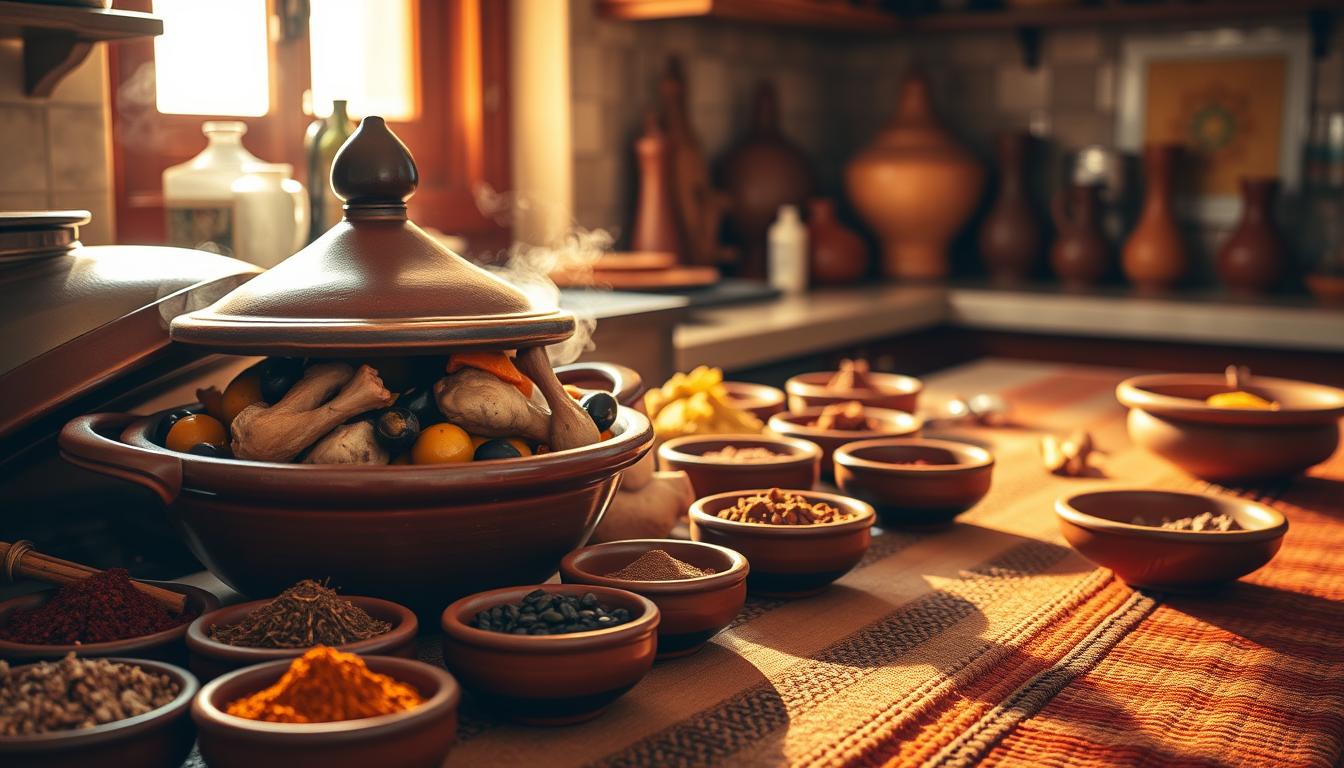
Traditional Flavor-Enhancing Techniques
Moroccan cooks use several traditional techniques to enhance flavors, including layering ingredients, using a mixture of spices, and incorporating preserved lemons and olives. These elements add a unique depth to the Tagine.
By mastering these techniques, you’ll be able to create a truly authentic Moroccan Tagine that delights your family and friends.
Serving and Presenting Your Tagine
The moment of truth arrives when you serve your Tagine, embodying the essence of Moroccan hospitality. Serving Tagine is not just about placing food on a plate; it’s an experience that involves tradition, aroma, and visual appeal.
Traditional Serving Methods
In Morocco, Tagine is typically served directly from the clay pot, maintaining the warmth and aroma of the dish. To achieve this, simply place the Tagine pot on a decorative stand or mat, and let it be the centerpiece of your dining table.
Garnishing for Authenticity
Garnishing your Tagine is crucial for authenticity. Common garnishes include fresh parsley, lemon wedges, and olives. For a more elaborate presentation, consider adding preserved lemons or a sprinkle of sumac.
Creating a Complete Moroccan Dining Experience
To create a complete Moroccan dining experience, consider serving your Tagine with traditional Moroccan bread, such as Khobz, and a side of salad or couscous. The key is to balance flavors and textures.
| Element | Description |
|---|---|
| Traditional Bread | Khobz or other Moroccan breads |
| Side Dishes | Salads, couscous, or pickled vegetables |
| Garnishes | Fresh parsley, lemon wedges, olives, preserved lemons |
Common Mistakes to Avoid When Cooking Tagine
Mastering the art of Tagine cooking requires understanding what not to do. Even with the right ingredients and equipment, certain mistakes can lead to a disappointing result. Here are some common pitfalls to watch out for.
Temperature Control Errors
One of the most critical aspects of cooking Tagine is maintaining the right temperature. Too high heat can cause the meat to toughen and the sauce to burn, while too low heat might result in undercooked ingredients. Aim for a gentle simmer to achieve tender meat and well-cooked vegetables.
Ingredient Layering Mistakes
The layering of ingredients in a Tagine is not just about aesthetics; it affects how flavors meld together. Incorrect layering can lead to uneven cooking and flavor distribution. Typically, you should start with aromatics at the bottom, followed by meat, and then vegetables and spices.
Spice Balance Problems
Balancing spices is crucial in Tagine cooking. Too much of any single spice can overpower the dish. Use a balanced mix of spices, and adjust according to your taste. Remember, you can always add more spice, but it’s harder to remove excess spice from the dish.
- Monitor your heat to avoid temperature fluctuations.
- Layer ingredients thoughtfully for even cooking.
- Taste and adjust spices as you go to achieve a balanced flavor.
Conclusion: Bringing Morocco to Your Kitchen
Cooking a delicious Tagine dish is more than just following a recipe – it’s about embracing the rich culinary traditions of Moroccan cuisine. With the steps outlined in this article, you’re now equipped to create an authentic homemade Tagine that will transport your taste buds to the vibrant markets of Marrakech.
As you experiment with different ingredients and techniques, you’ll discover the joy of Tagine cooking and how it can become a staple in your culinary adventures. Whether you’re a seasoned chef or a curious cook, the art of preparing a Tagine is sure to bring a new level of excitement to your kitchen.
So, gather your ingredients, dust off your clay Tagine pot, and get ready to savor the flavors of Morocco in the comfort of your own home. With every slow-cooked stew, you’ll be bringing a piece of Moroccan hospitality to your table, and creating unforgettable memories with family and friends.
FAQ
What is the best type of meat to use in a traditional Moroccan Tagine?
The most commonly used meats in a traditional Moroccan Tagine are lamb, chicken, beef, and fish. You can choose one or a combination, depending on your preference and the regional variation you’re aiming to replicate.
Can I make a Moroccan Tagine without a traditional clay Tagine pot?
Yes, you can make a Moroccan Tagine without a traditional clay pot. Modern alternatives like Dutch ovens or heavy pots with lids can achieve similar results. However, using a traditional clay Tagine pot can enhance the authenticity and flavor of your dish.
How do I season and care for my Tagine pot to ensure longevity?
To season your Tagine pot, coat it with oil and heat it slowly. For care, avoid sudden temperature changes, and clean it gently. Regular maintenance will help preserve your Tagine pot.
What are preserved lemons, and how are they used in Moroccan Tagine?
Preserved lemons are lemons that have been pickled in a brine solution. They’re a crucial ingredient in many Moroccan Tagine recipes, adding a salty, tangy flavor. You can make your own preserved lemons or buy them at most Middle Eastern or North African grocery stores.
Can I make a vegetarian or vegan Moroccan Tagine?
Yes, you can easily make a vegetarian or vegan Moroccan Tagine by substituting the meat with vegetables, tofu, or plant-based protein sources and adjusting the spices accordingly.
How long does it take to cook a traditional Moroccan Tagine?
Cooking times can vary depending on the ingredients and the heat level, but a traditional Moroccan Tagine typically cooks slowly over low heat for about an hour or more, allowing the flavors to meld together.
What’s the key to achieving the authentic flavors of a Moroccan Tagine?
The key to achieving authentic Moroccan Tagine flavors lies in balancing sweet and savory elements, using a blend of traditional spices, and cooking the ingredients slowly to allow the flavors to meld together.
Are there any regional variations of Moroccan Tagine that I can try?
Yes, there are several regional variations of Moroccan Tagine, including Northern, Southern, Berber, and coastal seafood styles. Each region has its unique twist, ingredients, and cooking techniques, offering a diverse range of flavors and experiences.
Check out The best Moroccan street food restaurants in Casablanca.

